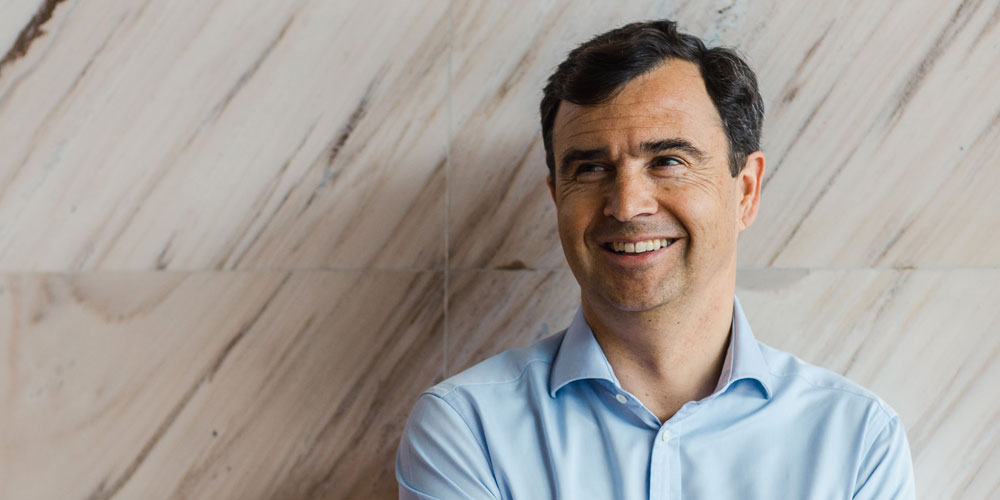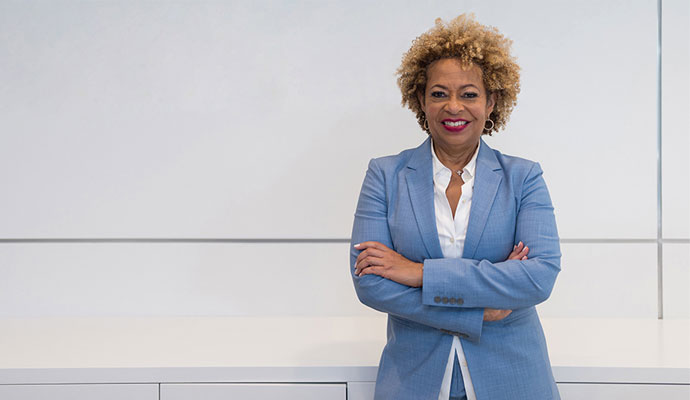Real estate company Jones Lang LaSalle aims to build a better world
CEO Christian Ulbrich on creating more innovative, sustainable, and community-friendly spaces.
This interview is part of the Inside the Mind of the CxO series, which explores a wide range of critical decisions faced by chief executives around the world.
Real estate is traditionally defined as the “where” of our work and personal lives. But Christian Ulbrich, CEO of global real estate services company Jones Lang LaSalle (JLL), believes the industry’s future lies at the intersection of the “where” and the “how”—reflecting people’s experiences in physical spaces and the effect those spaces have on the surrounding community and the world at large. Since taking the helm a little more than five years ago, Ulbrich has been outspoken in his view that buildings are more than walls and wires. They should embody safety, innovation, efficiency, and sustainability, and help people connect to one another. This imperative is more urgent than ever, as Ulbrich leads his company through an unprecedented change: the reimagining of the office by businesses worldwide, driven by the pandemic, technology, and changing modes of work.
Ulbrich, 55, has shaped his perspective over a long career in investment banking and real estate. After earning a master’s degree from the University of Hamburg, in Germany, Ulbrich spent ten years working in German and international banks. He then served as CEO of Hamburg-based real estate company HIH Group before joining JLL in 2005 as managing director for Germany. By 2009, he was CEO of the EMEA region, and in 2016, he was named global CEO. The company, which manages, occupies, buys, builds, and invests in industrial, commercial, retail, residential, and hotel real estate properties, has almost 100,000 employees in 80 countries and reported revenue for 2020 of US$16.6 billion.
In recent years, JLL has doubled down on technology investment. Within a year of being appointed CEO, Ulbrich launched JLL Spark, a $100 million venture capital fund that invests in property technology (proptech) startups. Two years later, in 2019, he created a new business division, called JLL Technology, devoted to helping clients accelerate their use of proptech. Ulbrich has also aggressively pursued a sustainability agenda. JLL made headlines in May 2021 when it committed to reaching net-zero emissions across its entire value chain by 2040. Ulbrich is a member of the World Economic Forum’s (WEF) Alliance of CEO Climate Leaders and partnered with WEF to develop the 10 Green Building Principles, a framework to help CEOs achieve their net-zero carbon targets. Ulbrich spoke with strategy+business about how technology and sustainability are transforming real estate.
S+B: How are the pandemic and economic uncertainty affecting your company? Your industry?
ULBRICH: I think we all thought a couple of times that the worst was behind us, and then we were proven wrong. We’ve seen that with Omicron. Still, I’m optimistic that 2022 will mark a return to normality to a large degree. In terms of the implications for the real estate industry, it depends on which part of the industry a business sits in. On the one hand, the retail and office sectors are impacted by potential declines in rental levels. But on the other hand, some sectors are benefitting from increased demand for space, including logistics and distribution, data centers, and laboratories.
For JLL, as a service provider, our role as an advisor has never been so critical. Companies are struggling with how to position themselves with their return to the office, which is dependent on local cultural practices and influences. In parts of the US, I’ve found that many people remain reluctant to go back into the office. Meanwhile, many of our clients in Asia have had staff eager to return as soon as they can. Elsewhere, I spent time recently in JLL’s Paris office, and, given social distancing requirements, we didn’t have enough space for all the people who wanted to work there.
S+B: How is the concept of “the office” changing in different regions?
ULBRICH: Aside from differing attitudes and virus situations, there are some countries and regions where we’re seeing some very exciting work spaces emerge. In Asia, for example, some companies are making a big effort to create offices that make people think, “It’s cool to work here. I want to come to the office.” The office needs to be a place for collaboration and connection—a place where you touch and feel the company’s brand and purpose. That is what buildings have to deliver, and they have to deliver it in a consistent way. We’re beginning to see this trend replicated elsewhere in the world; it is scaling fast in places such as the US.
Commercial real estate is also moving away from monoliths that are built in an area but aren’t really integrated into that area. This is true of the architecture itself, but it’s also about how space is being used. For example, there’s so much meeting space in buildings that is completely empty from 7 p.m. onward that you could make open to the public by hosting community events.
Consider JLL’s Shanghai office, which is hard to even tell is an office. It’s part of one of the most stunning developments in a great location in the city. You walk in, and it looks more like the lobby of a designer hotel, with green [planted] walls and water coming down the walls. Coming into that office feels more like entering a recreation center than a workplace. On the main floor, there is a gym and there are yoga classes taking place. Desks only take up about 25 to 30% of the overall building space. There is a floor that we call a collaboration space, where in the evening we have pop-up shows and exhibitions for our employees, clients, and friends. Because of these features, people see the office as more than just a place where they work.
As this trend spreads around the world, desk space will go down significantly. But that doesn’t mean that demand for overall office space will go down. The amount of experiential space, as you might call it, will increase even faster than desk space can be freed up. This shift will require customization based on local preferences and job profiles. It will also require cultural transformation within organizations. Tell experienced partners at some large firms that they won’t have a personal office anymore, and they will say, “I don’t want to sit with everyone else.” That’s a real challenge. But we have to do it, because if we don’t, people will leave. And talent is a major concern for many of our clients. Even for JLL, retaining and recruiting is the number two business risk when it comes to our day-to-day business operations. And it’s only number two because cybersecurity, which is a less controllable risk, is number one.
S+B: How is property technology, or proptech, going to help ease the transition in how and where we work?
ULBRICH: The pandemic has accelerated the need for technology within work spaces. One example is an increased need for sensors. You need to know where your people are in the office and how they’re using the office so that you can take necessary safety measures. In a hybrid situation, you also need meeting rooms to become media rooms, where you have all the tools teams need to feel like they’re working together, even if some people are at home and some are in the office.
Pre-pandemic, you would know that on Monday, your offices would fill up, and they would stay full until Friday afternoon. It was easy to run meetings, make announcements, and offer opportunities for collaboration. Now, it’s complicated, because you don’t know who is showing up when. You might also need technology for booking certain seats in a bank of desks to ensure that team members can sit near one another.
Though technology and data are the key pillars of any business now, the real estate industry has traditionally been slow to embrace them. Until a couple of years ago, buildings had very little technology embedded. That is changing now, and technology integration has significantly accelerated over the past two to three years—in particular, since the pandemic. At JLL, we started our own venture capital fund in 2017 and have invested in more than 30 different proptech businesses. We’ve made investments in AI, robotics, and building operations software. The creativity of these startups is incredible. I’ve learned so much about processes that can be optimized just by reading investment proposals. Sometimes, these proposals show me problems that I didn’t even know existed.
S+B: Can you give us a few examples of technologies that you think will make an impact?
ULBRICH: We are looking at investments that enable a cohesive technology strategy for managing a property or portfolio. Different types of technology we’ve invested in work together to this end. For instance, in November 2021, we acquired [US-based] Building Engines, which makes software that runs the core technology of a building. This is something we see as critical going forward, because all these other new technologies that have been invented and will be invented need to tie into something. Otherwise, you have 20 or 30 different types of software in your building, and each of them is running independently. That’s a nightmare for property managers, owners, and operators.
Another example, this one of a problem I didn’t know existed until I read the proposal, concerns insurance for property maintenance. In the US, when you work in a building to do any kind of maintenance, you need to prove that you are insured. For property managers, keeping track of all these different insurance policies for the various types of maintenance going on in a building at any given time is a very painful process. I was told that in a large building, it takes up to a full day per week for a property manager to just do that.
In September 2018, JLL invested in an [Israel-based proptech] called Jones, which has created a software that takes care of this process seamlessly. People who need to work in a building use the software to show proof of insurance, and then the software notifies the property manager that the insurance coverage is there. This has reduced the amount of time property managers spend on this process from one day per week to less than 50 minutes per week.
S+B: What role will AI play in real estate?
ULBRICH: I think AI will effect tremendous change in our industry. Right now, sales are very traditional, and there aren’t many data points being analyzed. Also, human beings are analyzing these data points, and they aren’t necessarily objective, because they have some biases before they even look at that data.
We invested in a company that we’ve since acquired, called Skyline AI, that analyzes publicly available data on buildings to forecast which properties might soon be put up for sale. The company can forecast this before the owner is even considering whether they should sell. The accuracy is stunning. We’ve been using this analysis in our multifamily business in the US since September 2021, and it’s changing the way we approach clients, because we can make improved recommendations about refinancing or selling, identify potential buyers, and see the comparable for-sale properties.
S+B: How can technology help the real estate industry reduce its carbon footprint?
ULBRICH: I think that technology and sustainability are tied together. What’s hard about the promise JLL made [in May 2021] to reach net-zero greenhouse gas emissions by 2040 is that we said we’ll eliminate 95% of that carbon and will only offset 5%. Anyone can say they’ll reach net-zero emissions, but the carbon they produce over time will still be there in the atmosphere. I’m a believer that innovation will help us in eliminating existing carbon. Already, in just the past five years, we’ve seen so much technology coming into play to solve this problem.
For new construction, it’s critically important that we stop developing any buildings that don’t meet the highest possible green standards, especially with regard to carbon footprint.”
There are two sources of carbon in buildings: you have the embodied carbon in the building and the operating carbon. Together, those sources of carbon account for about 40% of global energy-related carbon emissions. But in big cities, which is where our business is, we are talking about 65 to 70%.
Obviously, the embodied carbon in existing buildings is already in the air. For those buildings, we have to look at how we can significantly reduce the operating carbon. There will be technology that helps us, but it won’t be easy. We need software that captures information about a building’s operating carbon, and the software should probably be open source, so the whole world can work on improving it, applying it, and adapting it, and then benchmarking the information against one global standard.
S+B: Can you talk more about the importance of having consistent standards?
ULBRICH: As an example, 96% of our top 50 clients have already set a net-zero target. But only 11% of those companies have a plan—the others are still struggling to develop a credible plan. We are trying to help them find their way. That’s why we worked with the World Economic Forum to create the 10 Green Building Principles and have supported the SBTi [the Science Based Targets initiative, a collaboration aiming to help companies set science-based net-zero targets in line with the Paris Accords]. There are so many different standards in the world—by region, country, and city. We need to get to one global standard as a benchmark. That is critical to end the confusion and bring clarity, so that we don’t waste further time on the journey to net zero.
S+B: What challenges do you foresee for the industry in trying to meet net-zero targets?
ULBRICH: There is no easy solution for many buildings because of the way they are constructed—it is financially unattractive to try to decarbonize them. But if you sit on those assets, they’ll very quickly become stranded assets. The speed with which financial institutions are declining to finance those buildings and investors and fund managers are deciding not to buy them is amazing.
Our internal research shows rent premiums of 6% and sales premiums of close to 8% on buildings that have green certifications. Soon we won’t be talking about the premium afforded by green buildings, but rather the discount for brown buildings. And we have far more brown buildings.
For new construction, it’s critically important that we stop developing any buildings that don’t meet the highest possible green standards, especially with regard to carbon footprint. Several green certificates look at many different factors in determining a building’s green status. But we need to look specifically at the carbon footprint.
We also have to use green building technologies and building materials technologies at scale very quickly. For example, new construction obviously relies heavily on concrete. I recently read that the largest concrete production company in Germany has a bigger carbon footprint than the whole city of Munich. That puts into perspective how much change could quickly be produced by using cleaner concrete and the right building technologies. We have to do this around the globe, not only in the most developed countries, and have a consistent standard.
S+B: How optimistic are you that the real estate industry will meet its goals?
ULBRICH: I have become very optimistic. I met the CEO of a large concrete producer in the US recently, and I asked him what his number one priority was going forward. I thought he would say something about the pandemic, but he said, “Getting my carbon footprint down.” I responded that I was surprised and then asked him why. He said, “Well, it is a very important priority of my biggest shareholder, so it’s my number one priority.” That’s a very interesting message.
But sometimes, despite companies’ best intentions, it can be disappointing to see how long it takes to implement and scale the best practices that will work to meet net-zero targets and to become more innovative. Companies like JLL have a huge responsibility to push clients forward in this regard and help open their minds to new ways of doing things.
Author profiles:
- Amy Emmert is a senior editor of strategy+business.
- Jen Hafemann is an advisor to executives of financial-services firms. Based in Chicago, she is a partner with PwC US.
- PwC US partner Ian Nelson also contributed to this article.




